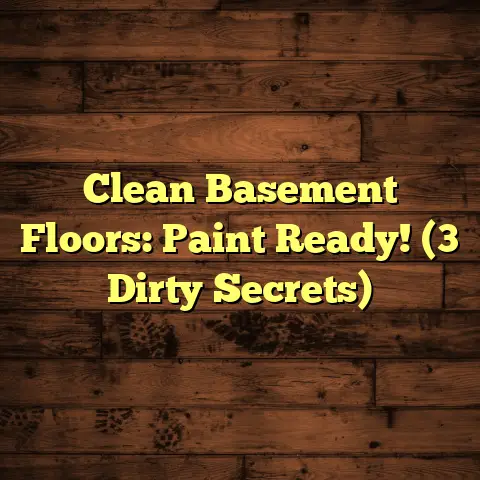Stop Sweaty Garage Floors (This Fix Works!)
Imagine this: You’ve just moved into your dream home, complete with a spacious garage. You envision it as a workshop, a storage haven, maybe even a home gym.
But then, reality hits. Every time you step into the garage, it feels damp, almost clammy. A musty smell lingers in the air. Sound familiar?
Meet the Johnsons. They bought their dream home, too, only to be greeted by this exact scenario. Their dream garage quickly turned into a source of frustration, a breeding ground for mold and mildew.
I’m going to walk you through what causes this frustrating issue, how to diagnose it, and most importantly, how to fix it. And trust me, the fix I’m going to share works.
1. Understanding the Problem: What Are Sweaty Garage Floors?
Let’s get one thing straight: “sweaty garage floors” isn’t just a cute nickname. It’s a real problem with real consequences.
What are the symptoms?
- Condensation on the floor
- Visible moisture buildup
- A damp or musty odor
- Potential for mold and mildew growth
Think of it like this: it’s the garage floor equivalent of waking up in a tent covered in morning dew. Not fun!
The Science Behind the Sweat
It all boils down to humidity, temperature fluctuations, and the nature of concrete.
Concrete is porous. It acts like a sponge, absorbing moisture from the ground and the air.
When warm, humid air comes into contact with the cool concrete floor, condensation forms. It’s the same principle behind a cold glass of water sweating on a hot day.
Poor ventilation exacerbates the problem, trapping moisture and creating the perfect environment for mold and mildew.
Why Should You Care?
Ignoring sweaty garage floors can lead to a whole host of problems:
- Damage to stored items: Cardboard boxes, tools, and anything else stored on the floor can become water damaged and ruined.
- Structural issues: Excessive moisture can weaken the concrete over time, leading to cracks and other damage.
- Health risks: Mold and mildew can trigger allergies, asthma, and other respiratory problems.
Trust me, addressing this issue early is worth the effort.
2. Identifying the Causes: Why Is Your Garage So Sweaty?
Now that we know what sweaty garage floors are, let’s figure out why they happen. Several factors can contribute to this problem:
- Climate Conditions: High humidity levels and significant temperature swings are prime culprits.
- Concrete as a Flooring Material: As mentioned earlier, concrete’s porous nature makes it susceptible to moisture absorption.
- Groundwater Seepage and Drainage Issues: If your garage floor isn’t properly sealed or if your property has poor drainage, groundwater can seep up through the concrete.
- Lack of Proper Ventilation: Without adequate airflow, moisture gets trapped, leading to condensation.
Regional Differences
The severity of the sweaty garage floor problem can vary depending on your location.
For example, homeowners in the humid Southeast are more likely to experience this issue than those in the arid Southwest.
Coastal regions, with their high humidity and salty air, also face unique challenges.
I’ve seen firsthand how different climates can impact garage floors. A client in Florida battled constant moisture, while a client in Arizona was more concerned about cracking due to extreme temperature changes.
3. Conducting a Diagnosis: Time to Play Detective!
Before you can fix the problem, you need to understand the source. Let’s walk through a step-by-step diagnosis process, just like the Johnsons did.
Step 1: Visual Inspection
Start by carefully examining your garage floor. Look for:
- Visible condensation or dampness
- Dark spots or discoloration
- Cracks or gaps in the concrete
- Signs of mold or mildew
Step 2: The Moisture Test
Tape a square of clear plastic wrap (about 1 foot by 1 foot) to the garage floor using duct tape. Make sure all edges are sealed tightly.
Leave it in place for 24 hours.
After 24 hours, check the plastic wrap. If you see condensation underneath the plastic, it indicates moisture is rising from the concrete.
Step 3: Sniff Test
Does your garage have a musty or damp odor? This is a telltale sign of moisture buildup and potential mold growth.
Step 4: Ventilation Assessment
Take a look at your garage’s ventilation. Do you have windows or vents? Do they provide adequate airflow?
If your garage feels stuffy and stagnant, poor ventilation is likely a contributing factor.
Step 5: Check for Leaks
Inspect the walls and ceiling of your garage for any signs of leaks. Water can seep in through cracks or gaps, contributing to the humidity problem.
What Did the Johnsons Find?
The Johnsons discovered several issues:
- Condensation on the floor, especially during temperature changes.
- A musty odor.
- Poor ventilation.
Based on their findings, they knew they needed to address both the moisture and the airflow.
4. Exploring Solutions: Your Arsenal Against Sweat
Alright, detective work is done! Now for the fun part: fixing the problem. Here are several solutions to combat sweaty garage floors:
Improving Ventilation: Let the Air Flow!
Proper ventilation is crucial for reducing humidity and preventing condensation.
- Open Windows and Doors: The simplest solution! Open windows and doors whenever possible to allow fresh air to circulate.
- Install Vents: Consider adding vents to your garage walls or roof to improve airflow.
- Exhaust Fans: Install an exhaust fan to remove humid air from the garage. Look for models specifically designed for garages.
Sealing the Floor: Creating a Moisture Barrier
Applying a sealant to your garage floor can prevent moisture from penetrating the concrete.
- Epoxy Coatings: Epoxy coatings create a durable, waterproof barrier that protects the concrete from moisture and stains.
- Concrete Sealers: Concrete sealers penetrate the concrete and create a water-repellent surface.
- Penetrating Concrete Sealers: These sealers react with the concrete to create a permanent, waterproof barrier.
Dehumidification: Taking Control of Humidity
A dehumidifier can remove excess moisture from the air, helping to prevent condensation.
- Choosing a Dehumidifier: Select a dehumidifier with a capacity suitable for the size of your garage.
- Placement: Place the dehumidifier in a central location in the garage.
- Maintenance: Regularly empty the water reservoir and clean the filter.
Insulation: Keeping Temperatures Stable
Insulating your garage can help to prevent temperature fluctuations that lead to condensation.
- Wall Insulation: Insulate the walls of your garage to reduce heat transfer.
- Ceiling Insulation: Insulate the ceiling to prevent warm air from rising and condensing on the cold concrete floor.
- Garage Door Insulation: Insulate your garage door to reduce heat loss and gain.
Installing a Drainage System: Dealing with Groundwater
If groundwater seepage is a problem, consider installing a drainage system to divert water away from your garage.
- French Drains: French drains are trenches filled with gravel that help to collect and redirect groundwater.
- Sump Pumps: Sump pumps can be used to pump water away from your garage.
5. The Fix That Works: The Johnsons’ Solution
So, what did the Johnsons do to conquer their sweaty garage floor? After researching their options, they decided to focus on two key areas: ventilation and sealing.
Here’s what they did:
- Improved Ventilation: They installed two gable vents in their garage walls to promote airflow. They also made a habit of opening the garage door for a few hours each day (weather permitting).
- Applied Epoxy Coating: They thoroughly cleaned and prepped the garage floor, then applied a two-part epoxy coating. This created a durable, waterproof barrier that prevented moisture from penetrating the concrete.
The Process (and the Challenges)
Applying the epoxy coating wasn’t exactly a walk in the park. They faced a few challenges:
- Surface Preparation: Proper surface preparation is crucial for epoxy adhesion. They spent a lot of time cleaning and etching the concrete.
- Application: Applying the epoxy evenly required patience and attention to detail. They followed the manufacturer’s instructions carefully.
- Curing Time: The epoxy needed several days to fully cure. They had to avoid using the garage during this time.
Despite these challenges, the Johnsons persevered. And the results were well worth the effort!
The Results
The Johnsons were thrilled with the outcome. The epoxy coating not only eliminated the moisture problem but also gave their garage floor a clean, professional look.
- Reduced Moisture Levels: The epoxy coating effectively prevented moisture from penetrating the concrete.
- Improved Air Quality: The increased ventilation and reduced moisture helped to eliminate the musty odor.
- Enhanced Garage Usability: The garage became a more comfortable and functional space.
6. Maintenance Tips: Keeping Your Garage Dry
The Johnsons’ story is inspiring! But the fight doesn’t end there.
Maintaining a dry garage floor requires ongoing effort. Here are some tips to keep humidity levels in check:
- Regular Inspections: Periodically inspect your garage floor for signs of moisture, cracks, or damage.
- Seasonal Adjustments: Adjust your ventilation and dehumidification strategies based on the season.
- Ongoing Ventilation: Continue to prioritize ventilation, even after implementing other solutions.
- Cleanliness: Keep your garage floor clean and free of debris.
7. Conclusion: Take Charge of Your Garage!
The Johnsons transformed their sweaty garage into a functional, dry space by understanding the problem, identifying the causes, and implementing the right solutions.
You can do the same!
Don’t let sweaty garage floors ruin your belongings, damage your home, or compromise your health. Take charge of the situation and implement the solutions discussed in this article.
Remember, a dry garage is a happy garage!
What are you waiting for? It’s time to say goodbye to sweaty garage floors once and for all!





